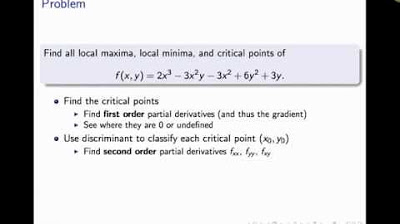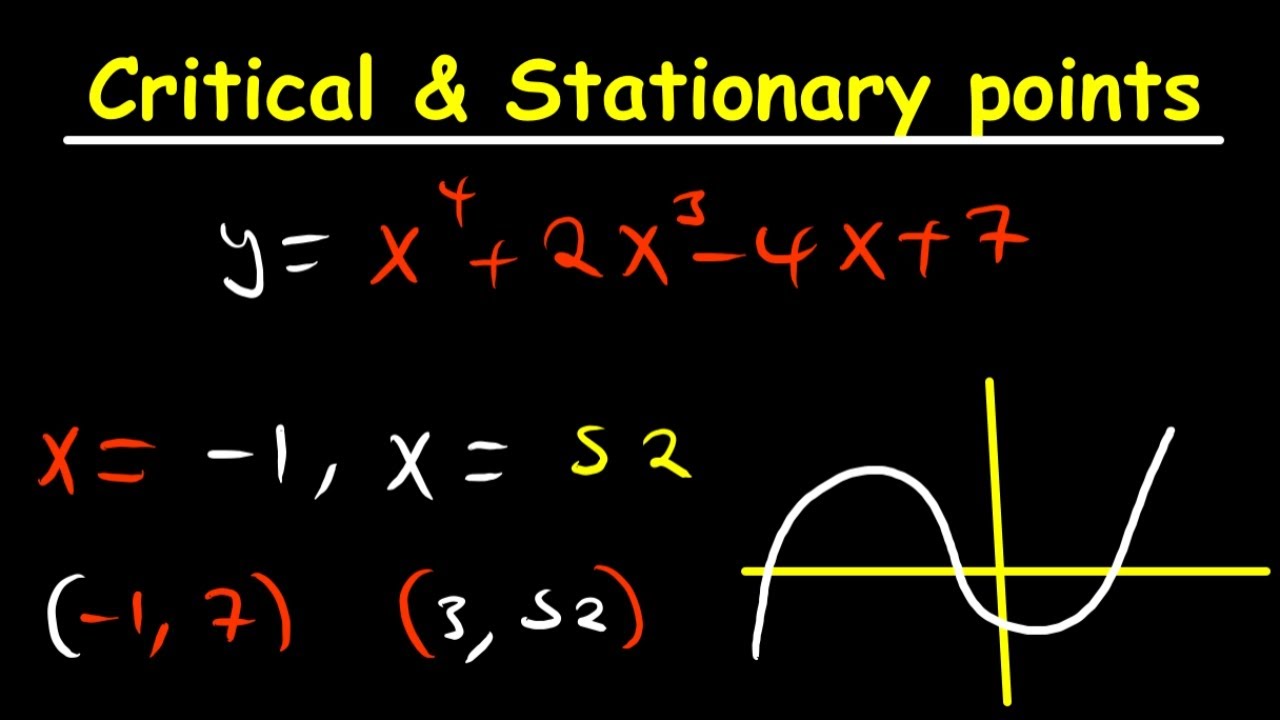Differentiation (Maxima and Minima)
TLDRThe video script discusses the concept of differentiation maxima and minima, focusing on identifying stationary points of a function where the gradient is zero. It guides viewers through the process of finding the coordinates of stationary points using the first derivative and determining whether these points are local maxima or minima by analyzing the second derivative. The script provides a step-by-step example, solving for the coordinates and nature of a stationary point on a given curve. It emphasizes the importance of the second derivative's sign to classify stationary points as maxima or minima, with positive indicating a minimum and negative indicating a maximum. The video concludes with an invitation to engage with additional resources and subscribe for future content.
Takeaways
- 📚 The video discusses the concept of differentiation maxima and minima, providing an educational resource for understanding calculus concepts.
- 📈 It explains that stationary points on a curve occur where the gradient (dy/dx) is zero, indicating horizontal tangents at the curve's peak or trough.
- 🔍 The script demonstrates how to find the coordinates of stationary points by setting the first derivative (dy/dx) equal to zero and solving the resulting equation.
- 🧐 To determine the nature of a stationary point as a maximum or minimum, the second derivative test is used, where d²y/dx² is calculated.
- 📉 If the second derivative at a stationary point is less than zero, it indicates a local maximum.
- 📈 If the second derivative at a stationary point is greater than zero, it indicates a local minimum.
- 📝 The video provides a step-by-step example of finding stationary points and their nature for a given function: x³ - 6x² + 9x + 1.
- 📚 The example finds the stationary points at coordinates (1,5) and (3,1), identifying the former as a local maximum and the latter as a local minimum.
- 🔢 Another example is given to find the stationary point and its nature for the function 4x² + x⁻¹, resulting in a stationary point at (1/2, 3).
- 📉 The second derivative test is applied to the second example, confirming that the stationary point at (1/2, 3) is a local minimum as d²y/dx² is positive.
- 👍 The video concludes with an invitation to engage with additional resources, such as exam questions and subscribing for future educational content.
Q & A
What are the characteristics of a function's graph at a point where it switches from increasing to decreasing or vice versa?
-At such points, known as stationary points, the function's graph has a tangent that is horizontal, which means the gradient is zero, so dy/dx equals zero.
How do you find the coordinates of stationary points on a curve?
-To find the coordinates of stationary points, you first set the first derivative of the function (dy/dx) equal to zero and solve for x. Then you substitute these x values back into the original function to find the corresponding y values.
What is the significance of the second derivative (d^2y/dx^2) in determining the nature of stationary points?
-The second derivative (d^2y/dx^2) indicates the rate of change of the gradient with respect to x. If d^2y/dx^2 is less than zero, the stationary point is a maximum. If it is greater than zero, the stationary point is a minimum.
How can you determine if a stationary point is a maximum or minimum without graphing the function?
-You can determine the nature of a stationary point by calculating the second derivative of the function. If the second derivative at the stationary point is negative, it's a maximum; if it's positive, it's a minimum.
What is the first step in finding the nature of a stationary point using differentiation?
-The first step is to find the first derivative (dy/dx), set it equal to zero, and solve for x to find the x-coordinates of the stationary points.
How does the gradient of a function change as you move past a maximum point on its graph?
-As you move past a maximum point, the gradient starts as positive, becomes zero at the maximum, and then turns negative as the function begins to decrease.
What is the relationship between the gradient of a function and the concavity of its graph?
-The gradient of a function indicates the slope of the tangent to the graph, while the concavity indicates whether the graph is curving upwards or downwards. A positive second derivative (d^2y/dx^2) indicates the graph is concave up, while a negative second derivative indicates concave down.
What is the role of the first derivative test in finding stationary points?
-The first derivative test involves setting the first derivative (dy/dx) equal to zero to find potential stationary points. It helps in identifying where the function's rate of change is zero, which are the points of interest.
How does the second derivative test help in classifying stationary points?
-The second derivative test involves evaluating the second derivative (d^2y/dx^2) at a stationary point. If it is positive, the point is a local minimum; if it is negative, the point is a local maximum.
What is the difference between a local maximum and a local minimum?
-A local maximum is a point on the graph where the function reaches a peak and then starts to decrease, while a local minimum is a point where the function reaches a trough and then starts to increase.
Why is it important to consider both the first and second derivatives when analyzing stationary points?
-The first derivative helps to locate stationary points, while the second derivative provides information about the nature (maximum or minimum) of these points. Together, they give a comprehensive understanding of the function's behavior at these points.
Outlines
📈 Understanding Stationary Points and Differentiation
This paragraph introduces the concept of stationary points in calculus, which are points on a curve where the gradient or derivative is zero. The video provides an example by differentiating a given function to find when dy/dx equals zero. It explains that at these points, a tangent to the curve would be horizontal. The process of finding the coordinates of stationary points involves solving the equation formed by setting the derivative to zero. The video also touches on how to identify whether these points are local maxima or minima by examining the curve's behavior.
🔍 Determining Nature of Stationary Points Using Second Derivative
The second paragraph delves into how to determine the nature of stationary points—whether they are maxima or minima—without graphing. It explains the use of the second derivative, d²y/dx², which is the derivative of the gradient function. The video illustrates that at a maximum point, the gradient starts positive, decreases to zero, and then becomes negative, making the second derivative negative. Conversely, at a minimum point, the gradient starts negative, increases to zero, and then becomes positive, making the second derivative positive. The video applies this concept to a new function, finds a stationary point, and then uses the second derivative evaluated at that point to confirm it is a minimum.
Mindmap
Keywords
💡Differentiation
💡Maxima and Minima
💡Stationary Points
💡Gradient
💡First Derivative
💡Second Derivative
💡Quadratic
💡Factorization
💡Local Maximum and Minimum
💡Graphical Interpretation
Highlights
Differentiation maxima and minima are explored in the video.
Exam questions related to the topic are available in the video description.
Gradient function (dy/dx) is used to identify increasing and decreasing sections of a curve.
Stationary points are where the gradient is zero, indicated by a horizontal tangent.
Coordinates of stationary points are found by setting the first derivative equal to zero.
Example given to find stationary points involves differentiating a cubic function.
Quadratic equation is solved to find x-values for stationary points.
Y-values are calculated by substituting x-values back into the original equation.
Differentiation is used to determine if stationary points are local maxima or minima.
Second derivative test (d²y/dx²) helps identify the nature of stationary points.
A positive second derivative at a stationary point indicates a local minimum.
A negative second derivative at a stationary point indicates a local maximum.
The rate of change of the gradient function is crucial for determining maxima and minima.
Second derivative is found by differentiating the first derivative again.
Example demonstrates finding the nature of a stationary point using the second derivative.
The video concludes with a summary of the process and an invitation to engage with additional resources.
Transcripts
Browse More Related Video
5.0 / 5 (0 votes)
Thanks for rating:





